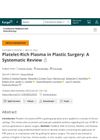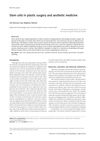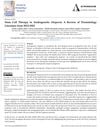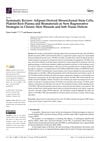TLDR Research on platelet-rich plasma in cosmetics has grown, but better studies are needed.
The bibliometric analysis of 306 articles on platelet-rich plasma (PRP) in cosmetics from 2001 to 2022 reveals a growing interest in PRP's potential for tissue regeneration, particularly in the United States, which leads in publications and citations. The study highlights the collaborative nature of research, with contributions from 45 countries, and identifies key authors and institutions. Despite low institutional cooperation, significant scientific innovation is noted, with a focus on PRP's efficacy in cosmetic applications such as skin rejuvenation, alopecia treatment, and scar management. The analysis underscores the need for large-scale, high-quality randomized clinical trials and anticipates future research on advanced PRP formulations and personalized treatments.
 4 citations
,
January 2022 in “Transfusion Medicine and Hemotherapy”
4 citations
,
January 2022 in “Transfusion Medicine and Hemotherapy” Platelet-Rich Plasma (PRP) has potential benefits in plastic surgery, especially for skin grafts, wound healing, hair loss, mild Carpal Tunnel Syndrome, and TMJ disorders, but more research is needed to confirm its effectiveness.
 31 citations
,
January 2019 in “Journal of Cutaneous Medicine and Surgery”
31 citations
,
January 2019 in “Journal of Cutaneous Medicine and Surgery” Platelet-Rich Plasma (PRP) therapy can promote hair growth and improve facial aesthetics, including reducing acne scars and facial burns, and it works best with three initial monthly injections.
 23 citations
,
October 2018 in “Expert Opinion on Drug Safety”
23 citations
,
October 2018 in “Expert Opinion on Drug Safety” Consider benefits and risks of new alopecia treatments for safety.
 76 citations
,
February 2021 in “International Journal of Molecular Sciences”
76 citations
,
February 2021 in “International Journal of Molecular Sciences” Mesenchymal stem cells show potential for skin healing and anti-aging, but more research is needed for safe use, especially regarding stem cells from induced pluripotent sources.
 January 2023 in “Postępy Dermatologii i Alergologii”
January 2023 in “Postępy Dermatologii i Alergologii” Stem cells can improve wound healing, reduce scars, promote hair growth, rejuvenate skin, and enhance fat grafts in plastic surgery, but there are still some concerns.

Stem cell therapy shows promise for treating hair loss in androgenetic alopecia.
 70 citations
,
February 2021 in “International Journal of Molecular Sciences”
70 citations
,
February 2021 in “International Journal of Molecular Sciences” Fat-derived stem cells, platelet-rich plasma, and biomaterials show promise for healing chronic skin wounds and improving soft tissue with few side effects.
March 2024 in “Cosmetics” New regenerative techniques show promise for improving skin, healing wounds, and growing hair.
 132 citations
,
January 2017 in “International Journal of Molecular Sciences”
132 citations
,
January 2017 in “International Journal of Molecular Sciences” Fat-derived stem cells show promise for skin repair and reducing aging signs but need more research for consistent results.








